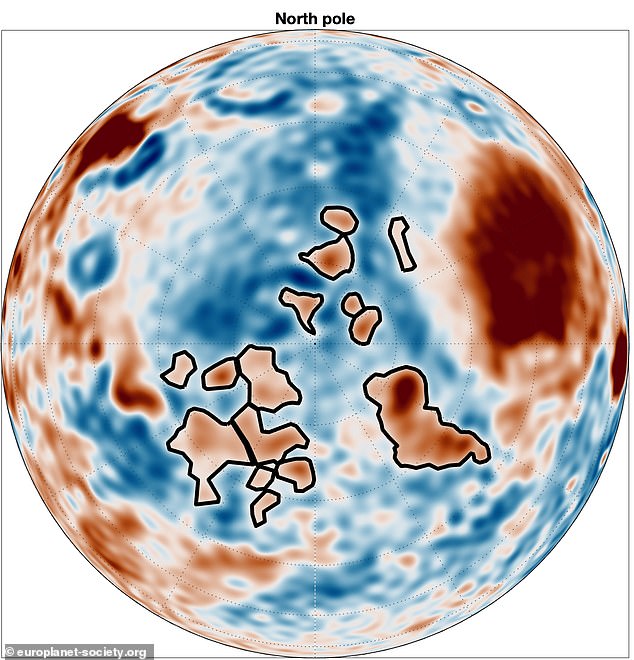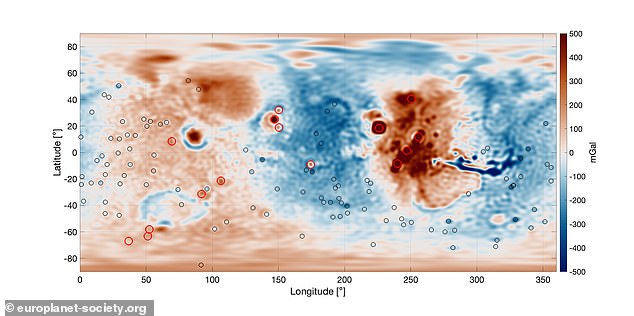New map of Mars reveals hidden ‘structures’ beneath Martian surface
A new map of Mars has revealed mysterious structures hiding beneath the sediment layers of a lost ocean.
The researchers discovered about 20 structures scattered across the planet’s north polar cap that are significantly denser than their surroundings.
The structures vary in shape and size, with one resembling the shape of a dog, leaving the team confused as they don’t know exactly what the formations are or where they came from. But they do have some theories.
One theory is that the structures were compacted by ancient meteorite impacts or that they were created by volcanic activity. However, more research is needed to determine the cause of these subsurface anomalies.
A new analysis of Mars’ gravity field has revealed mysterious structures lurking beneath the planet’s surface
The research team from the Danish TU Delft and Utrecht University presented their findings this week at the Europlanetary Science Conference in Berlin.
The team used tiny deviations in the orbits of satellites to create an image of Mars’ gravity field, or the region of space around a planet where gravity is felt.
They did this to look for clues about how mass is distributed across the planet’s subsurface.
The team then combined these observations with data on the thickness and flexibility of the Martian crust, and on the dynamics of the mantle and deep interior of the planet.
These observations were collected by NASA’s InSIGHT lander, which completed its exploration of Mars’ crust, mantle and core in 2022.
This allowed the researchers to create a global density map of Mars, which revealed 20 previously unknown subsurface structures scattered across the planet’s northern polar cap.
The structures are approximately 19 to 25 pounds per cubic foot denser than their surroundings and vary in shape and size.
In addition, they are covered with a thick, smooth layer of sediment, which may once have been the sea floor.

The researchers used small deviations in satellite orbits and data from NASA’s InSIGHT lander to create a global density map of Mars

Their analysis revealed 20 previously unknown subsurface structures scattered across the planet’s northern polar cap
Billions of years ago, Mars was not the desert planet we know today. It was once covered with oceans and rivers, but the water dried up in an extreme climate shift.
The only evidence for the existence of these bodies of water is found in the geological history of Mars, such as this sediment layer.
According to Bart Root, lead author and assistant professor at TU Delft, ‘there seems to be no trace of the structures that are underneath on the surface.’
“But gravity data gives us an intriguing glimpse into the older history of Mars’ northern hemisphere.”
This isn’t the first time scientists have discovered strange things beneath the surface of Mars.
In December 2023, China’s Zhurong discovered large honeycomb-shaped cracks buried tens of meters beneath the Martian equator. These cracks likely formed when drastic drops in temperature caused the ground to contract and crack.
But Root and his team are having a harder time figuring out what these most recent structures are and where they came from. Right now, they have two main theories.
Either the structures were compressed by ancient impact events, such as meteorites, or they were formed by some kind of volcanic activity. The latter idea challenges scientists’ long-held view that Mars is a geologically inactive planet.
Although research has shown that Mars does not have as much geological activity as Earth, there is growing evidence that the planet is not completely ‘dead’.
Root’s research adds to this evidence, not only by discovering structures that may have formed volcanically, but by making an entirely different discovery.
In addition to the mysterious structures the team discovered, the analysis revealed that geological processes may still be occurring in Mars’ mantle that could feed Olympus Mons, the largest known volcano in the solar system.
Olympus Mons is located in the Tharsis Montes region, near the Martian equator. Scientists estimate that the volcano has not erupted in 25 million years.
The subsurface geology of the Tharsis region is incredibly dense, but Root and his team discovered a much lighter mass 1,130 kilometers below the surface.
He believes that this mass is a huge plume of magma that extends over 1,000 miles into the Martian mantle. Furthermore, this plume could be about to bubble up to the surface.
“This means we need to rethink how we understand support for the Olympus Mons volcano and its surroundings,” Root said.
“It shows that there may still be active movements happening on Mars, affecting and potentially creating new volcanic formations on the surface.”
